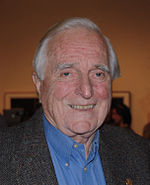Portal:San Francisco Bay Area/Selected biography/35

Douglas Carl Engelbart (January 30, 1925 – July 2, 2013) was an American engineer and inventor, and an early computer and Internet pioneer. He is best known for his work on the challenges of human–computer interaction, particularly while at his Augmentation Research Center Lab in SRI International, resulting in the invention of the computer mouse, and the development of hypertext, networked computers, and precursors to graphical user interfaces. These were demonstrated at The Mother of All Demos in 1968.
In the early 1950s, he decided that instead of "having a steady job" (such as his position at NASA's Ames Research Center) he would focus on making the world a better place, especially through the use of computers. Engelbart was therefore a committed, vocal proponent of the development and use of computers and computer networks to help cope with the world’s increasingly urgent and complex problems. Engelbart embedded a set of organizing principles in his lab, which he termed "bootstrapping strategy". He designed the strategy to accelerate the rate of innovation of his lab.
Under Engelbart's guidance, the Augmentation Research Center developed, with funding primarily from DARPA, the NLS to demonstrate numerous technologies, most of which are in modern widespread use; this included the computer mouse, bitmapped screens, hypertext; all of which were displayed at The Mother of All Demos in 1968. The lab was transferred from SRI to Tymshare in the late 1970s, which was acquired by McDonnell Douglas in 1984, and NLS was renamed Augment. At both Tymshare and McDonnell Douglas, Engelbart was limited by a lack of interest in his ideas and funding to pursue them, and retired in 1986. (more...)
